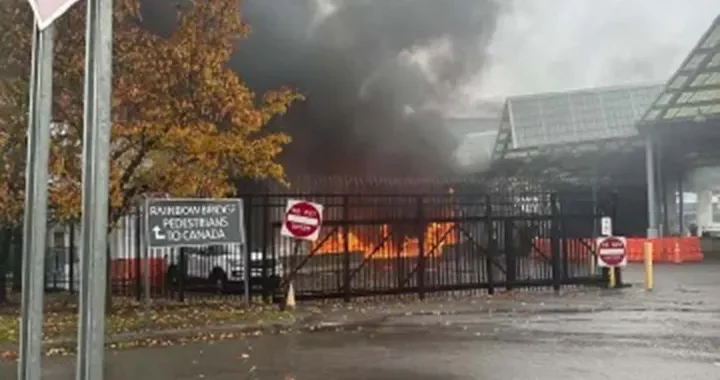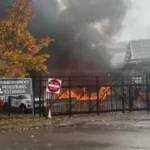272,000 out of power in Florida: Idalia Impact.

Idalia Sets Its Sights on Georgia After Leaving Its Mark on Florida
Idalia, the formidable storm that had Floridians holding their breath, has now moved into Georgia, leaving its imprint on both states. As it entered Georgia southeast of Valdosta around noon on Wednesday, Governor Ron DeSantis provided updates on its path.
A fortunate shift to the east during the night saved Tallahassee from bearing the brunt of Idalia’s 125 mph hurricane-force winds. Additionally, the storm’s rapid northeast movement reduced the duration of time that the capital city was exposed to tropical storm winds.
Governor DeSantis expressed relief, stating, “This northeast shift really played in favor of Tallahassee. Despite the rain and some debris, the change in direction helped us out.”
Amidst the chaos, an ancient oak tree at the Governor’s mansion was split in two by the storm’s force. Governor DeSantis, with a hint of humor, remarked that if the tree needs to be removed, it might provide more space for his three children to play. He said, “Although the tree was nice, we’ll manage fine and probably be alright.”
Officials reported that Idalia was the most significant storm to hit the Big Bend area, matching the windspeed of a nameless 1896 storm that struck Cedar Key.
As of noon on Wednesday, over 272,000 households were grappling with power outages. However, restoration efforts were underway, with more than 262,000 customers regaining power overnight and into Wednesday morning. Particularly concerning was the situation in Madison County, where 99% of the area was without power. Restoration crews were dispatched to begin the arduous task of bringing back electricity.
Transportation woes added to the aftermath, with debris blocking SR 24 into Cedar Key and SR 51 into Steinhatchee. The Florida Department of Transportation activated about 700 crew members to clear roads and inspect approximately 1,000 bridges across the Nature Coast and adjacent areas.
Despite the initial challenges, Governor DeSantis expressed some optimism. He noted, “We seem to have fared well across most of the counties, except for the direct hit in the Big Bend area. The Tampa Bay region appears to be in good shape, Leon County is holding up well, and we’re still assessing the situation on the ground.”
While preparations were underway, the Taylor County Emergency Operations Center had to evacuate its premises when Idalia’s wind speed peaked at 125 miles per hour while still offshore. As the storm made landfall, it began to lose some of its intensity.
In Perry, a weather station recorded gusts of 85 mph as Idalia moved through the area at a speed of 18 mph. Cedar Key, located south of Keaton Beach where the storm landed, reported a gust of 65 mph. Wind speeds elsewhere were reported at 59 mph at Horseshoe Beach, with gusts of 73 mph in Lafayette County, 58 mph at St. Mark’s Lighthouse, and 48 mph on the campus of Florida A&M University in Tallahassee.
One silver lining was that Idalia struck the Nature Coast during low tide, which minimized the potential for a devastating storm surge of up to 10 feet. Although Tampa experienced a surge of over 5 feet and St. Petersburg saw a surge of 3.5 feet, other areas were spared the feared 10-foot surges.
In a morning update, Governor DeSantis issued a stern warning to Floridians as Hurricane Idalia made a historic and catastrophic landfall in Taylor County. He emphasized, “Stay indoors during the storm. Find a safe place and hunker down. This is a very, very powerful storm.”
Initially classified as a Category 4 storm, Idalia had been downgraded to a Category 3 by the time it hit the Big Bend region. Its ferocity brought with it a life-threatening storm surge.
This storm marked the most intense one to strike the Big Bend in over a century, causing destruction through powerful winds and flooding across the Panhandle, peninsula, and Atlantic Coast.
With wind speeds surpassing 130 miles per hour upon landfall, the Taylor County Emergency Operations Center had to relocate to a more secure facility at the airport. At the time of landfall, approximately 54,000 households were without power. Just 45 minutes later, that number had escalated to 170,000 customers in a broad area extending from Tallahassee to Central Florida.
While the Nature Coast counties of Wakulla, Jefferson, Taylor, and Dixie faced significant challenges, it was evident that Florida’s capital city, Leon County, was also not in the clear yet. Leon County Commissioner Christian Caban warned, “This storm will leave a lasting impact on our communities. Expect downed trees, blocked roads, power outages, flooding, and hazardous conditions. It’s crucial to follow all emergency directives.”
The Florida Public Service Commission reported more than 268,000 customers without electricity by 10 A.M., including over 40,000 households in Tallahassee.
With 49 counties under a state of emergency, dangerous winds persisted throughout Wednesday. Idalia’s hurricane-force winds extended up to 15 miles from its center, and tropical storm winds reached as far as 160 miles. The Perry area in Taylor County was at the center of the storm’s wrath, raising concerns about tornadoes and flooding from Tallahassee to Melbourne.
Governor DeSantis took decisive action, mobilizing 5,500 National Guard troops and coordinating eight search and rescue teams. The state had also secured 1.1 million gallons of fuel and Starlink internet dishes to aid in the aftermath.
Reflecting on the preparations, Governor DeSantis acknowledged, “The counties, on the whole, have done a commendable job in handling this situation.”
According to the National Hurricane Center, Idalia’s strength diminished as it crossed the state. A weather station in Perry reported sustained winds of 62 mph with gusts of 85 mph as the storm swept through Taylor County.
Forecasters warned of potential tornadoes spawned by the storm and advised residents to brace for prolonged power outages. The Florida Department of Transportation strategically positioned 650 trucks and heavy equipment units across Central and North Florida to facilitate road clearing and support power restoration. A workforce of over 30,000 linemen stood ready for cleanup and restoration tasks, as weather conditions allowed.
Despite concerns, some areas experienced less severe storm surges than anticipated. Tampa saw a surge of up to six feet overnight, while Wakulla, which was bracing for a significant surge, ultimately avoided the worst.
The last major hurricane to impact Florida was Ian, claiming 144 lives from drowning due to surging water a year prior. Governor DeSantis expressed his intent to hit the road post-storm to assess the damage and offer assistance to affected communities.
By: M Z Hossain, Editor Sky Buzz Feed













